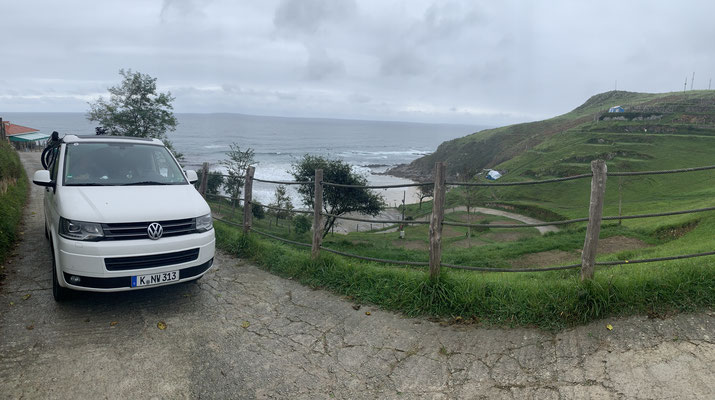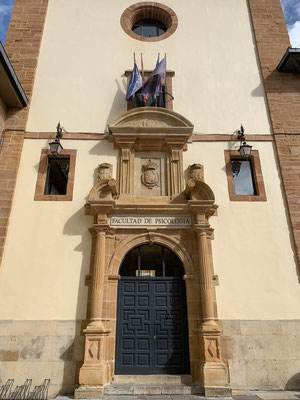
Like the days before, we are woken up by rain. Today it is a gentle pattering. - As there is no improvement in the forecast for the rest of the day, we decide to do as the migratory birds do and move on. - So we say goodbye to San Vicente de la Barquera. But not without making one last stop. The town rewards us with a wonderful farewell view of the Castillo del Rey. Unfortunately, the old town with the Romanesque church behind it can no longer be seen from here.
We continue parallel to the coast, with the road running through hilly and later even mountainous terrain. After just a few kilometers, we leave Cantabria behind us. We cross the Río Deva in Unquera and have now arrived in Asturias.
As we continue along the road, a few hikers keep coming into our field of vision. Armed with walking sticks and colorful rain ponchos, they hike along the road. - We are on a Way of St. James. The Camino del Norte, also known as the coastal path, seems as gloomy as the weather in this section. Instead of following the sea, it simply follows the road. The walkers also seem gloomy. The main aim seems to be not to get run over or splashed. - What motivates people in the 21st century to hike this ancient pilgrimage route? I would like to know what is going on inside one or two hikers. They all seem to be searching. Is it also the search for happiness - are they dealing with strokes of fate? - We don't know, but maybe it's just the next level. - We simply wish the hikers to find themselves, happiness, forgiveness... - whatever it is.
We are getting hungry. So we turn onto a small side road near Buelna and try to make our way towards the sea. Our first attempt ends up in a small village and a dead end on a dirt road by the cemetery. We are slowly becoming too specialized in the subject of turning the van around in a confined space. - So we move on. We start our next attempt near Vidiago. The little road is a little wider and seems to lead towards a campsite. - But we didn't expect what we found at a small bay. At the bottom of a small, rocky bay there is nothing but a reception. Next to it, a steep path winds its way up the cliff. We promptly decide to explore the place called "La Paz". The path is so steep that the tires threaten to spin on the rain-soaked road. I wouldn't want to drive a large camper up here. The site supposedly has over 400 pitches. Not exactly what we like. But these are scattered over a large area laid out in individual terraces so that everyone can set up their own domicile. The special thing about it is that every pitch seems to have an equally magnificent view. - We are thrilled, even though it is raining cats and dogs and the bay looks gray in gray. In the end, we notice one place that is really special. It is already occupied by a single tent and hangs over the sandy beach like an eagle's nest. If it wasn't so early in the day, we would have stayed. So we drive back down to the bay, park Hector on the beach and have a leisurely breakfast. Speaking of breakfast. - Over the last few days, we've become more and more accustomed to just having a coffee in the morning, then having breakfast at lunchtime and not eating again until the evening. It's not therapeutic fasting, but it's almost intermittent fasting, isn't it? We think that fits in with the Way of St. James. - As we set off again, we see the next pilgrims. They still have over 400 kilometers to walk to Santiago de Compostela. But all those who started in Brittany, at the Abbaye Maritime de Beauport, the supposed kilometer 0, have already covered 1,200 kilometers. The rest is almost a stone's throw away. - At first, we are happy to be traveling with Hector. But then we remember the smell of the fresh, dew-covered grass growing at the foot of the road markings and the wild mint in between. Not only delicious, but wonderfully fragrant. You only get these impressions when you pause or go on a pilgrimage. Perhaps the pilgrims were not so gloomy, perhaps they were just introspective, enjoying the landscape. - We don't know, so everyone goes their own way. OK, we're off.



The landscape becomes increasingly mountainous and resembles Switzerland a little. But here the sea is always close enough to touch. - We are getting closer and closer to our destination for the day, Oviedo. When we arrive, we park at the Jardines del Campillín and walk through the old town from here. Not only the cathedral and the old Romanesque churches are impressive. It is not without reason that the old town is a UNESCO World Heritage Site.



After strolling around for a while, we stop at the Cathedral of Oviedo, also known as the Cathedral Basilica of San Salvador, in Plaza Alfonso II el Casto. - In the time of King Alfonso II, the Chaste, the Way of St. James began here, hence the saying: "He who goes to Santiago and not to Salvador visits the servant and not the master"




No wonder that many pilgrims still visit this place today. - I used to think that all roads lead to Rome, but today they seem to lead to Compostela. - The cathedral of Oviedo is closed, contrary to the opening hours. But seeing this place from the outside would be reason enough to visit the city. - The adjoining Garden of the Kings is also closed to us. We'll have to come back sometime. -



We make our way to our next stop, Santa María del Naranco, three kilometers northwest of Oviedo and at the foot of Monte Naranco.
Originally built in the middle of the 9th century as the belvedere of a palace complex, it was only later used as a church. - Church or not, the place is simply beautiful. Torgit therefore also tries to be a Buddha. Surely this would also have been a place to enjoy the sunset. But we want to get back to the sea and decide to head towards Carreño.




You might wonder why we camp so little in the wild. This would certainly be easy at this time of year. But in the mornings and evenings it is still, or already quite chilly. So it's nice to at least have a warm, unfortunately never hot, shower. - We find a nice place called "Camping Perlora" with a view of the sea. There we meet Alexandra and David. - They are traveling in their self-built Opel Vivaro camper. Alexandra has already traveled around a bit and lived in Cologne's Agnesviertel for a while. A little bit of Cologne is everywhere. David is a likeable native Bavarian. - Late in the evening we philosophize a little about camping and then about happiness. Although they both seem very content, it takes a little while to define what constitutes happiness. - Do we all ask ourselves the question "What makes me happy?" too rarely?
But one realization remains, not new, but always confirming. - Less is more.
Insight of the day: Eating and looking at the sea is simply more than just eating or looking at the sea.


Recent Comments